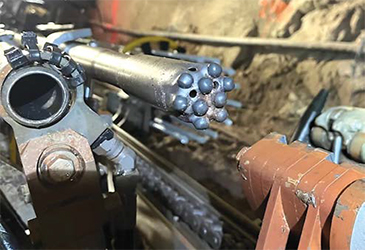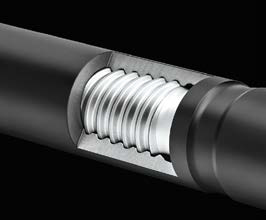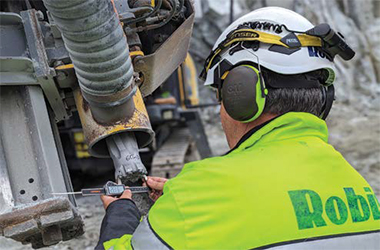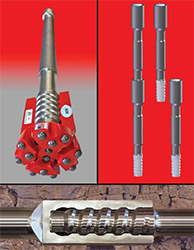
Powerbit X has diamond-protected buttons that
guarantee superior hardness, resulting in higher
average penetration rates and sustained performance,
even in abrasive conditions, Epiroc reported.
(Image: Epiroc)
Drilling Tool Innovations
Improve Productivity
Enhancements that increase component performance and longevity
are currently or will soon change rig specifications
By Jesse Morton, Technical Writer

Diamond-protected Buttons
Early adopters say the Powerbit X helped
them increase productivity, improve safety,
and simplify logistics. Results from
two underground mines and a major underground
civil works project show the bit
delivers significant time and cost savings
by improving operational efficiencies.
The customers said the bit exceeded
expectations at solving the specific challenges
for which it was adopted.
The superior performance is due to “advanced Polycrystalline Diamond (PCD) technology” that “revolutionizes drilling performance,” said Jonas Falkeström, strategic business development manager, Epiroc. “This drill bit features diamond-protected buttons, ensuring unparalleled durability and wear resistance,” he said. “Drill bits where the buttons are coated with diamond protect your people, your productivity and the environment.”
The bit is designed to maximize “drilling efficiency, significantly extending bit life and minimizing operational downtime,” Falkeström said. “The use of PCD guarantees superior hardness, resulting in higher average penetration rates and sustained performance, even in abrasive conditions.”
It also delivers a consistent result. “Constant hole dia. is essential for efficient and even blasting,” Epiroc said. “When using a traditional drill bit, the dia. gets reduced over time, leading to smaller and smaller holes.”
The diamond-protected buttons maintain their shape “throughout the lifetime of the bit,” the supplier said. “The fact that the holes are of the same size every time improves both the blasting quality and the life of the drilling equipment.” It also improves productivity. “Powerbit X lets you realize the full potential of remotely and automatically controlled production,” Falkeström said.
With a long bit life, Powerbit X makes it “possible to drill in auto-mode over lunch breaks, shift changes and blast ventilation cycles,” Epiroc said. Beyond reducing downtime for bit changes, it increases the average drilling speed. “An operator can complete a single hole with only one drill bit,” Falkeström said. “The alternative with in-hole bit replacements is time-consuming and quickly adds substantial productivity losses,” he said. “It is possible to save hundreds of hours by changing to this new technology using diamond-protected buttons.”
Goran Popovski, president of the tools and attachments division at Epiroc, said the longer service life of the bits means fewer changes and therefore less exposure to danger. “Powerbit X is a game-changer when it comes to safety.”
Downstream benefits include faster project completions, less equipment wear, and improved operational efficiency. “Importantly, the Epiroc Powerbit X’s hard surface eliminates the need for re-sharpening, offering a tremendous opportunity for simplifying logistical challenges related to bit maintenance in mining operations,” Falkeström said.
Regrinding is eliminated. “When a Powerbit X drill bit is finally worn out, it is time for recycling, not regrinding,” Epiroc said. The superior performance, efficiency gains and longer service life can translate to fewer CO2 emissions per drilled meter, “by up to 90%,” Epiroc said. “The long bit life of Powerbit X means that less energy and resources are consumed,” it said. “A reduced need for drill bits in the mining operation also leads to fewer transports, both on the way to the mine and in the mine.” PCD technology was first developed by the oil and gas industry. “Initially faced with challenges in the 1970s, PCD bits were slow to gain acceptance due to durability and design issues,” Falkeström said. “Advancements in cutter materials and bit design eventually led to their widespread adoption and dominance,” he said. “However, the diffusion of PCD technology in the mining industry and blasthole applications has been comparatively sluggish.”
For a while, the price was too high and the benefits too few. “In recent years, Epiroc has made substantial investments in research and development to unlock the potential of PCD technology for mining applications,” Falkeström said. “These efforts have yielded several technical breakthroughs in bit design and adaptations of PCD technology for percussive drilling,” he said. “The timing for this technology in mining is opportune.”
Powerbit X launched in H1 2022. Trials began a Boliden’s Garpenberg zinc mine. The mine was advancing its use of automation solutions and sought a bit that would not require frequent replacement. “Reducing the number of bit changes was key to move the operators away from dangerous areas but would also help increase the production with fewer interruptions per drilled meters,” Epiroc said.

In August 2023, Epiroc said the Eti Bakir Murgul copper mine in Turkiye was using Powerbit X when excavating preparation tunnels through “daunting” and “abrasive, copper-rich rock formations.” The miner adopted the bit as an answer to the “hurdle” of frequent bit changes. “We were intrigued by the potential of the Epiroc Powerbit X and the Epiroc SR35 system to address this issue,” said Tayfun Erdogan, technical coordinator, Sargin Insaat AS.
Among other “remarkable” results, the “Powerbit X and Epiroc SR35 system drilled more meters per shift and lasted significantly longer than our previous equipment,” said Fahri Kara, mine operator, Sargin Insaat AS. “It has significantly improved our drilling operations.”
The bit gave a longer lifespan, which meant the miner required “fewer deliveries, a significant advantage,” said Hakan Diken, operational manager, Sargin Insaat AS. Adoption of the bit accelerated the development of the mine. “With the current pace of development, we seem to be able to complete the job earlier than initially estimated,” Diken said. “The Epiroc Powerbit X and the Epiroc SR35 system are enablers for our ambitious plans and development pace.”
In Q4 2023, Epiroc reported that a Powerbit X had drilled 3,250 m for the Sofia metro station construction project in Stockholm. Project leadership said the solution was adopted after frequent bit changes contributed to inefficiencies. “We needed a complete bolting solution that could keep up with the project’s ambitious goals,” said Daniel Zetterman, machine manager, Implenia. Two bits were trialed. “This was the first time we used the Epiroc Powerbit X in a bolting or ground support application, and these two bits have surpassed all of our expectations and the results are remarkable,” said Mattias L. Andersson, sales representative, Epiroc Rock Drilling Tools. The bits achieved “higher penetration rates of up to 0.5 m per minute more when compared to conventional drill bits,” Epiroc said.
The longer lifespan of the Powerbit X simplified logistics. “Normally we would have to re-grind a standard bit four or five times to reach 400 to 500 m,” Zetterman said. “As we don’t do regrinding on site, this means substantial savings in transportation in city traffic and handling from staff,” he said, “a huge advantage for us.”
Epiroc said that, so far, the big hurdle to more widespread market acceptance is normalcy bias. “The challenge we have when communicating this product to the market, is that is sounds to good to be true,” said Fredrik Ternström, head of strategic communication. “People tend to be skeptical about those things.”
The many benefits realized by early adopters indicate that bias will inevitably be defeated, Falkeström said. “With increasingly stringent safety standards, mounting pressure on underground mines to enhance production efficiency at greater depths, and a heightened focus on environmental friendliness, the Epiroc Powerbit X now plays a crucial role in the ongoing transformation of the mining industry.”
‘The Perfect Thread’
Sandvik officially launched the new
CT55 system for the Ranger DXi and
Pantera DPi rigs, and the new CT67
system for underground long-hole drilling.
The hammer tool systems feature
a “first-of-its-kind curved thread design”
that reduces breakage for longer drilling
and improved production.
A Sandvik expert on top hammer tools said the thread design reduces stress levels by distributing them over a larger area. The female thread “has a thicker material closer to the bottom of the thread where it is needed,” said Fredrik Björk, product manager, top-hammer surface tools. “By doing that we are reducing the stress levels in the female,” he said. “Similar for the male, it will be stronger closer to the root.”
The curve design allowed Sandvik engineers “to move material where needed to lower stresses and increase the fatigue strength,” Björk said. “Doing this resulted in a much stronger geometry of the thread.” In contrast, a normal straight thread design allows stresses to concentrate “in a very small point,” said Robert Grandin, product manager, top-hammer underground tools. “And that generates a very big load on that particular point,” he said. “But when you have a curved thread like this, then you spread out those stresses over a much larger area.” The result is “dramatically reduced thread wear.”

Less time wasted “is the biggest benefit and that can result from both automated- or manned-drilling as well because we don’t see the interruption from breakages that you used to see on standard products,” Grandin said. “It is an easier product to use,” both for operators and in automated drilling.
Less time is lost contending with a transversal breakage. Early adopters say results show “the time for fishing went down 80%,” Grandin said. “This is especially important for underground operations where tool breakages create frustration and interruptions.” “You can lose an hour or hours when that happens,” Grandin said. “That is waste. You do that much less with CT. It is a big difference.”
The thread design “also makes the CT system automation-ready, since easy coupling and uncoupling in itself is an important enabler for automation, a vital technology in many underground operations,” he said. “That is one of the things that fueled the design project, that it should be very user friendly so that it is easy to couple and uncouple.”
Efficient handling and less downtime can translate to improved productivity. “Our design increases productivity by 15% while reducing fuel consumption by 15%, as faster drilling means less flushing time,” said Anders Brungs, vice president, Product Line Top Hammer, Sandvik. Some of those productivity gains are due the system’s ability “to handle higher drilling power and a drill rig’s full potential,” Sandvik reported. “The higher productivity of the CT systems can be reached with more aggressive settings for parameters like percussion, rotations and feed.” The system “brings out the full potential of Ranger DXi and Pantera DPi rigs,” Björk said. With the new thread design, tool service life is extended by as much as 30%, he said.
The new thread design was first conceived as a theoretical solution to a perplexing, longtime problem. “The industry standard thread system is very old,” Björk said. “We have been working with them with minor improvements over the years.” But then engineers hit a wall. “We needed more performance from them,” he said. “We could not stay within the designs to be compatible with the old industry standard. That is why we looked at completely new concepts.”
Roughly a decade ago, “we started using these simulations tools” and “one of the engineers said to me once, ‘I’d like to make the perfect thread,’” Björk said. “And then he was imagining how to eliminate or reduce stress at certain points,” he said. “It was a good target: the perfect thread. That was a nickname for the project.” Ten years later, new Sandvik rigs feature design improvements that are the downstream results of the new thread design. “The rigs going out of the factory now are different because of this product,” Grandin said. “We are actually changing the specifications of the rigs so they can accommodate this product better,” he said. “Both in hardware and also software.”
Within the last year, early adopters have reported results that indicate future success of the top-hammer systems. “There are already contracts signed on all continents,” Grandin said. “Don’t miss out,” he said. “Talk to your local Sandvik reps and set up a trial.”
Related research and development continues. “If something works as well as this one does, then it is almost criminal not to start scaling it in all directions,” Grandin said. “We have activities ongoing.” The new CT55 and CT67 top-hammer tool systems will be showcased at MINExpo.
Separately, Sandvik introduced the Golden Shank with corrosion protection coating. “Sandvik’s new Golden Shank is equipped with a patented, low-friction, nickel-plated coating with a polymer top sealant for improved corrosion resistance,” Sandvik said. “Applied throughout the entire shank and flushing slot, except for the striking area, this unique coating minimizes wear on flushing seals and rock drill parts and reduces breakages on other rig and tool machine parts.”
Benefits include increased service life and lower drilling cost per meter. “Field tests confirm 30% to 100% longer product life,” Sandvik said. “Even at mine sites where corrosion is not prevalent, Golden Shank field tests have consistently demonstrated 2-3 times longer performance life than other similar market options.”
By reducing operator handling, the solution offers safety gains, the company said. “Prioritizing operator safety and minimizing environmental impact through reduced tool replacements are critical considerations in our product development process,” said Thomas Blomfeldt, product manager, top hammers, Sandvik. “The Golden Shank will enable some customers to potentially double efficiency.”
Optimized Button Layout,
Face Geometry
Robit said field results show its new
Rbit-series bits deliver performance improvements
over predecessor bits.
“When comparing drill tool manufacturers, a customer tends to focus on cost per bit or cost of bit over the lifetime,” said Leif Olmstead, sales engineer. “However, if we look at the total drilling cost, tooling cost is very low when compared to variable costs, such as labor costs, fuel consumption, supervision, and parts and maintenance.”

“This means that we can provide the precise bit a customer would need for their specific conditions from a standardized base design,” he said. “The concept was put in practice in 2022 and is today delivering consistent quality to drillers around the world.” The new base design is exemplified in Rbit top-hammer bits. “Improvements to our top hammer bits achieve faster rates of penetration in order to lower the customer’s total drilling cost,” Olmstead said. “Robit’s aim was to make energy transfer from the bit to the rock more efficient and improve the flow of the flushing air, or air and water mixture, to clear the rock cuttings better,” he said. “This was done by optimizing button layouts and introducing new face geometry.”
The button layout configuration ensures “maximized rock contact and energy transmission,” company literature said. “A new transition face was developed to improve the transfer of percussion energy into the rock.” The enhanced flushing design delivers an “even faster rate of penetration,” Robit said. “Redesigned wider retrac grooves that allow more space give a better flow for the cuttings.”
Robit bits are “manufactured with recyclable 100% Green Steel,” the supplier said. “Consistent top quality is guaranteed by fully automated production lines,” it said. The bits “are finalized with eco-friendly water-based paint.” An underground mine in Finland reported that Rbit-series bit performance delivered significant cost savings. “There, we were allowed to do an extensive audit of the mine’s regular operating parameters and compare that to test data of a full Robit drill string,” Olmstead said. “The performance and cost of the Robit long-hole drill string was shown to be able to generate a 12% savings in annual total drilling cost.”
Guided Cylindrical Contact
Zones
Rockmore said the Vector Rod System
with the XT thread design is now
field-proven and gaining in popularity.
The system garners “repeat sales,” said
Ronnie Edwards, regional sales representative.
“It works great,” he said, “and
so they keep buying it.”
When integrated with the Vector Rod System, the XT thread design uses guided cylindrical contact zones between the male and female thread joints that “help keep the drill string running straighter and keeps everything tighter and more proficient,” Edwards said. “Thus, the XT thread design employed in the Vector Rod System enables many performance and reliability benefits leading to major overall cost savings in the drilling cycle,” Rockmore said. The design gives a longer life, better energy transfer, enhanced drilling performance, and helps lengthen the life of other components of the drill string.

Another advantage is, “when it comes time to break the steel apart, it comes apart easier,” Edwards said. “It will also help you if you have hole deviation, which will cause breakage,” he said. The guide will limit the damage. “It won’t completely stop it, but it will help reduce it.” The Vector Rod System can use XT38, XT45, XT51, and XT60 thread types. The XT thread is also “compatible with industry-standard thread types such as T38, T45, and T51,” Rockmore said.
Most of the time, “the customer wants to run it with the XT bits and steel combined,” Edwards said. “You get the benefits of the full strength.” The Vector Rod System and thread design was engineered as a solution to a challenge raised by customers. “We knew that a guidance issue was something that needed to be addressed,” Edwards said.
New Piston, Barrel Wall
Design
Kova Drilling Applications said it will introduce
its down-the-hole (DTH) hammer
in Australia in 2024. “We are in discussion
with some partners in South America,
Peru and Chile, and also in South Africa,”
said Hari Rajagopal, vice president,
sales. The hammers have “been around
for the last seven or eight years, but were
introduced in the U.S. last year.”
Compared to typical designs, the hammer is “completely reimagined,” Rajagopal said. It features “a new piston technology that is optimized for long strokes,” he said. “The piston travels around 15% longer distance and hits the hammer harder than other major brands.” The longer piston stroke “translates to a much faster penetration rate on hard rocks in drill-and-blast applications,” he said. “The other cool thing about this technology is it uses a thicker wall,” Rajagopal said. “The wall thickness is consistent across the length of the hammer, so the product lasts longer.”
Competitor hammer barrels are grooved inside, “resulting in a thinner material, thinner wall,” he said. “Ours is consistently thicker, and with more material it lasts longer.” The hammer can last as long as 30,000 ft or 9,150 m. The hammer is compatible “with several types of drill bits,” Rajagopal said. “The shank is compatible with our mission shank, the QL shank and also SD shank,” he said. “These different types of shanks can accommodate all types of drill bits made by third parties.”
Competitor designs have the air intake on the side of the piston. With the Kova hammer, the air intake is at the top and bottom of the piston. “The technology to move the piston up and down is inside the piston,” Rajagopal said. The design “went through several iterations,” he said. “We did a lot of design simulations, followed by several hundred field trials.” The result is a solution that is “very different from what is on market.”
The field trials were by a customer of one of the major brands. “They reluctantly tried our hammer,” Rajagopal said. “They were pleasantly surprised,” he said. “They said your hammer performed similar or slightly better than” the competition. The hammers were also trialed in “pure black granite, usually the hardest to drill,” Rajagopal said. “And they got better results there as well,” he said. “So far, all of the drillers who are using our hammer, testing our hammer, have given positive results.”
Customers said the solution is easy to assemble and service. “This has the lowest number of parts in the industry,” he said. It is only around 14 parts, compared to 19 or above for other hammer brands.” Customers also said it was cost efficient. “Our product cost/m is around 20% less than the major brands,” Rajagopal said.